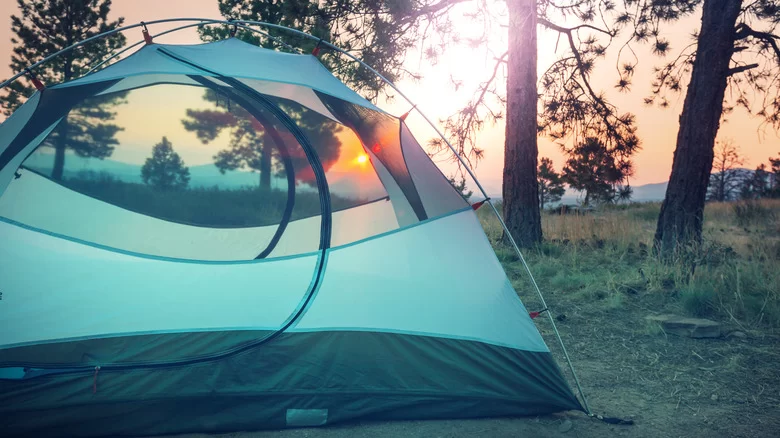- Understanding Dispersed Camping in the USA
- Best Regions for Free Dispersed Camping
- Essential Preparations for Dispersed Camping
- Real Experiences and Practical Tips
- Why Choose Pine Cliff Resort for Your Camping Needs
1. Understanding Dispersed Camping in the USA
Dispersed camping, often referred to as free camping in the USA, is the practice of camping outside of developed campgrounds, usually on public lands such as national forests and Bureau of Land Management (BLM) areas. Unlike traditional campgrounds, dispersed camping allows campers to set up their tents or park their RVs away from crowds, offering a more secluded, natural experience.
This style of camping appeals to adventurers who seek tranquility, solitude, and a deeper connection with nature. However, it requires a greater level of preparation and respect for the environment. Campers must practice Leave No Trace principles to preserve these pristine areas.
Understanding the rules and regulations is critical because not all public lands allow dispersed camping. For example, some areas may require permits or have seasonal restrictions. Learning where and how you can camp freely is the first step towards a successful trip.
What Makes Dispersed Camping Unique?
Unlike crowded campgrounds, dispersed sites typically lack amenities such as restrooms, potable water, or fire rings. This means campers need to bring their own supplies and be prepared for a more self-reliant experience. The freedom to camp where you want also means you can wake up to breathtaking sunrises, uninterrupted wilderness views, and the sounds of nature.
2. Best Regions for Free Dispersed Camping
The USA is vast and offers numerous prime locations for dispersed camping, each with unique landscapes and experiences. Some of the top regions include:
National Forests Across the West
National forests in states like Colorado, Oregon, and California are among the best for free dispersed camping. These forests often allow camping almost anywhere outside developed sites, provided you follow regulations. For example, the San Bernardino National Forest in California is popular for its proximity to urban centers yet offers plenty of remote spots.
Bureau of Land Management (BLM) Lands
BLM lands span millions of acres, especially in the western USA, including Nevada, Utah, and Arizona. These lands are typically open for dispersed camping with minimal restrictions. One notable area is Utah’s Grand Staircase-Escalante National Monument, which offers stunning desert landscapes and hidden camping gems.
Appalachian Wilderness Areas
For those on the East Coast, dispersed camping is available in the Appalachian National Forests. While more regulated than western lands, there are still excellent opportunities for quiet wilderness camping amidst lush forests and mountain vistas.
3. Essential Preparations for Dispersed Camping
Before heading out to a dispersed camping site, thorough preparation is vital to ensure safety and enjoyment.
Research and Planning
Start by researching the specific public land where you plan to camp. Check for rules about camping duration, fire restrictions, and vehicle access. Many forest and BLM websites provide maps and guidelines. It’s important to know whether you need a permit or if the area is seasonally closed.
Packing the Right Gear
Because dispersed camping means no amenities, pack essentials such as water, food, a portable stove, first aid kit, and a reliable tent. Water purification tools are crucial if you plan to source water from nearby streams. Also, bring adequate clothing layers to adapt to changing weather.
Safety and Environmental Respect
Dispersed campers must always practice Leave No Trace ethics: pack out all trash, avoid damaging plants, and use established fire rings only where allowed. Campfires are often prohibited during dry seasons to prevent wildfires.
4. Real Experiences and Practical Tips
One memorable story comes from a couple who ventured into the Gila National Forest in New Mexico for dispersed camping. They shared how waking up to the quiet rustling of wildlife and a pristine starry sky made their trip unforgettable. They emphasized the importance of arriving before dark to choose a safe, flat spot and of respecting wildlife by storing food securely.
Another camper’s tip is to use your vehicle to explore before choosing your site, as some dispersed camping areas may have rough or narrow access roads. They also recommend informing a friend or family member about your location and expected return, adding a layer of safety.
Technology and Navigation
Using GPS devices or offline maps can prevent getting lost in vast wilderness areas. Many campers find smartphone apps designed for backcountry navigation invaluable, but they should not rely solely on electronic devices due to battery life concerns.
5. Why Choose Pine Cliff Resort for Your Camping Needs
For adventurers planning their dispersed camping trips, Pine Cliff Resort offers an excellent resource to find the right gear, supplies, and expert advice tailored for wilderness camping in the USA. Whether you need durable camping equipment, off-road vehicles, or knowledgeable guides, Pine Cliff Resort is dedicated to helping outdoor enthusiasts prepare thoroughly and enjoy their journeys safely.
They also provide information on the best free camping locations and how to access them responsibly. By choosing Pine Cliff Resort, you gain a trusted partner who understands the unique challenges and joys of dispersed camping.
For anyone seeking to explore the great outdoors with confidence and comfort, Pine Cliff Resort is a name worth knowing.







